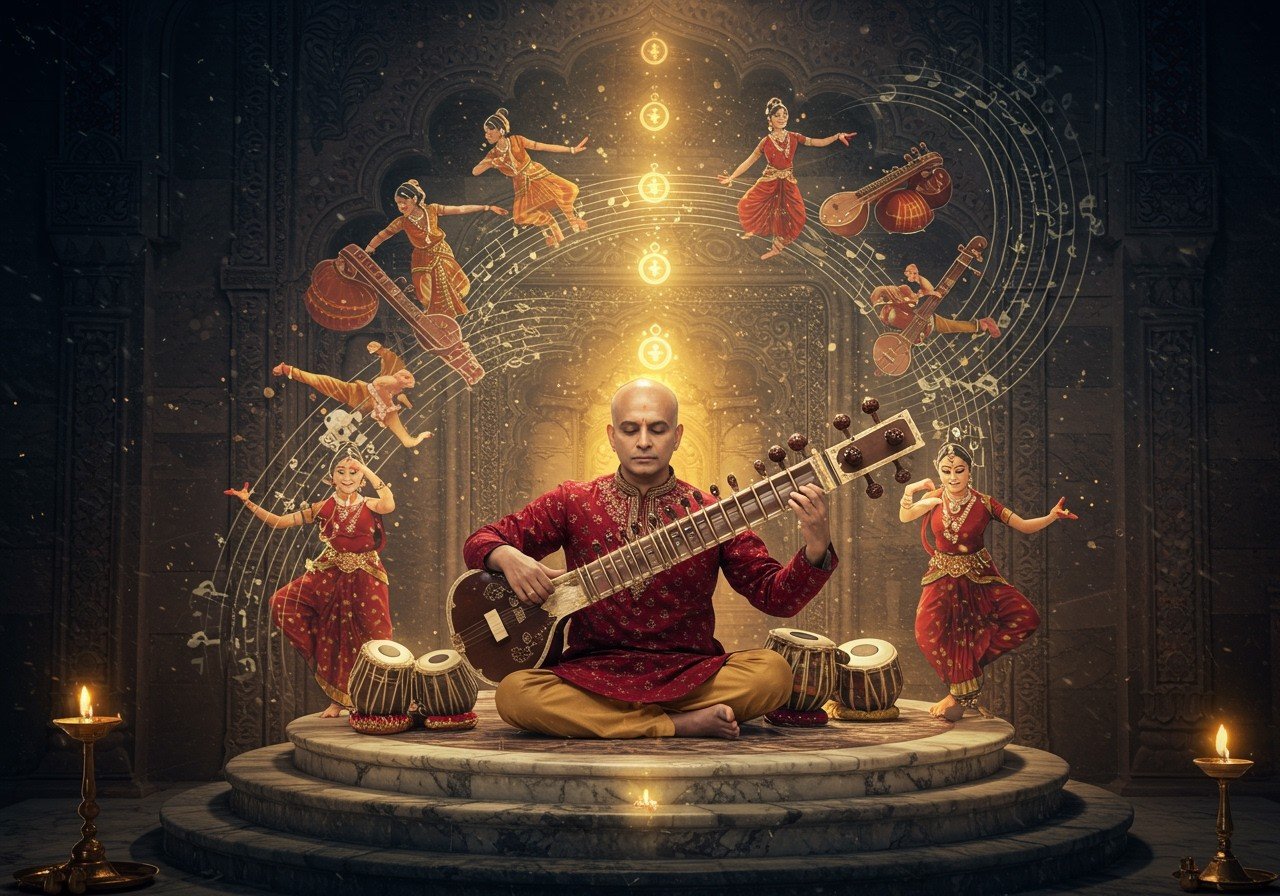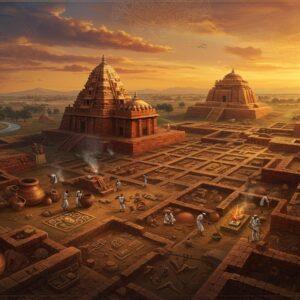
Indian classical music offers a rich and immersive experience, with ragas at its core. These melodic frameworks shape the mood and emotion of the music, embodying centuries of cultural and historical significance. They are integral to India’s diverse musical heritage, deeply resonating with those who cherish tradition and authenticity. Both the Hindustani (North Indian) and Carnatic (South Indian) traditions feature ragas, each offering a unique expression of India’s vast musical landscape.
What is a Raga?
A raga isn’t merely a musical scale; it’s a vibrant framework for improvisation and creativity within Indian classical music. Each raga possesses a unique identity, defined by specific notes, melodic motifs, and a set of rules that guide its development. At the heart of a raga lies its rasa, the emotional essence that gives it character and purpose. Ragas are often associated with particular times of the day or seasons, adding a deeper layer of meaning to their expression.
Think of a raga as a melodic roadmap for musicians. It provides structure while leaving ample room for improvisation and individual expression. It’s through this delicate balance of structure and freedom that ragas come alive, each performance a unique interpretation of the raga’s essence.
Key aspects of a raga include:
- Melodic Structure: Each raga boasts a unique array of melodic structures and musical motifs, creating its distinctive identity. This intricate tapestry of sounds is what sets one raga apart from another.
- Emotional Significance: Ragas possess the power to evoke specific emotions in listeners. They can stir feelings of joy, peace, devotion, or longing, connecting with us on a deep emotional level.
- Framework: A raga serves as a structured framework of melodic notes. It typically uses a combination of seven primary notes (swaras), similar to the concept of scales in Western music.
- Rasa: Each raga has its own emotional character, or rasa. This can be associated with a range of emotions like love, humor, tranquility, or valor, adding a profound layer of meaning to the musical experience.
- Evolution: Ragas have evolved over centuries, passed down through generations of musicians. Interpretations can vary across different musical traditions, showcasing the dynamic nature of this art form. The most pronounced variations are between Hindustani (North Indian) and Carnatic (South Indian) classical music.
- Performance Timing: To enhance their emotional impact, musicians often perform ragas at specific times of day or during particular seasons. For example, some ragas are traditionally associated with the morning, while others are best suited for the evening or specific seasons like the monsoon.
While hundreds of ragas are recognized, only about 30 are commonly performed today. This curated selection represents the most popular and enduring ragas in the vast repertoire of Indian classical music.
Ragas in Music: A Journey Through Melodies and Emotions
Indian classical music is a captivating journey through emotions and time, with ragas serving as our guiding stars. They are more than just sequences of notes; they are narratives that unfold through melodies. Musicians utilize ragas to weave enchanting tales of love, devotion, and the beauty of nature. Each performance becomes a unique rendition, a spontaneous expression of the raga’s essence, where the musician improvises within its established framework. It’s akin to painting with music, where each stroke is distinct yet contributes to a cohesive whole.
The Versatility of Ragas in Performance
Ragas shine brightly in both vocal and instrumental music, providing a boundless canvas for singers and instrumentalists to showcase their creativity. Their magic lies in their versatility, allowing for a wide range of interpretations and expressions. Different gharanas, or schools of music, bring regional flavors to the ragas, enriching the musical landscape with diverse perspectives. Each gharana has its own distinct approach, making every performance a fresh and engaging experience.
In Hindustani music, compositions like dhrupad, khayal, and thumri find their roots in ragas. In Carnatic music, kritis and varnams showcase the beauty and complexity of ragas. Composers like Tyagaraja and Muthuswami Dikshitar have left an indelible mark on this tradition with their invaluable contributions.
Ragas in Contemporary Music: A Bridge Between Tradition and Innovation
Ragas are not confined to the realm of tradition; they readily embrace innovation, seamlessly blending into contemporary genres like fusion and film music. This adaptability keeps ragas alive and relevant in today’s ever-evolving musical world. Ragas also find a place in music therapy, offering a soothing balm for the mind and soul, promoting well-being through the power of melody and rhythm.
Ragas in English: Bridging the Cultural Gap
Translating the concept of ragas into English-speaking contexts presents unique challenges. The English language often lacks equivalent musical terminology to fully capture the nuances and subtleties of ragas. However, dedicated ethnomusicologists and scholars work tirelessly to bridge this cultural gap, introducing the richness of Indian classical music to Western audiences.
Cross-Cultural Collaborations: A Fusion of Musical Worlds
Ragas serve as a wellspring of inspiration for musicians worldwide, leading to enriching cross-cultural collaborations. Jazz and world music discover new dimensions through the incorporation of ragas, creating a vibrant tapestry of sound that resonates with global audiences.
A wealth of English-language resources, books, and journals delve into the study of ragas, offering valuable insights for those eager to learn about this unique musical tradition. Renowned Indian classical musicians generously share their experiences and knowledge with international audiences, fostering a deeper understanding and appreciation for this art form.
The Significance of Ragas in Indian Culture: A Tapestry of Tradition and Spirituality
Ragas hold profound cultural and spiritual significance in Indian society. They are woven into the fabric of religious practices, such as bhajans (devotional songs) and kirtans (chants), where music becomes a powerful form of devotion, connecting individuals to the divine. Traditional dance forms like Bharatanatyam and Kathak intertwine music and movement, with ragas serving as their very soul, expressing emotions and narratives through graceful gestures and rhythmic footwork.
Ragas in Celebrations and Education: Preserving Cultural Heritage
Ragas play a central role in festivals and celebrations, uniting communities in harmony and shared cultural experiences. They also serve as invaluable educational tools, preserving and transmitting cultural heritage across generations. The time-honored guru-shishya tradition (teacher-student) ensures that the knowledge and practice of ragas are passed down through direct mentorship, nurturing future generations of musicians.
Ragas continue to influence popular culture, finding representation in literature, cinema, and other art forms. They resonate deeply with the modern world, where tradition harmoniously meets innovation. This dynamic interplay keeps the essence of ragas alive and thriving, even as the world evolves around us.
How Poojn.in Supports Your Musical Journey
At Poojn.in, we understand the deep connection between music, spirituality, and tradition. We offer a curated selection of puja items that beautifully complement your exploration of Indian classical music and ragas.
Musical Instruments for Worship:
- Pure brass bells (ghanta) with different tonal qualities, perfect for creating a sacred atmosphere during your musical practice.
- Conch shells (shankh) for producing sacred sounds that resonate deeply with tradition and spirituality. Our conch shells are carefully selected for their quality and authenticity.
- Traditional manjiras (hand cymbals), essential for accompanying devotional songs and creating rhythmic patterns that enhance the musical experience.
Visit www.poojn.in to explore our complete range of authentic puja items. For personalized assistance with selecting items for music-related rituals, contact us:
- Phone: 03369029784
- WhatsApp: 9476142738
Our experts can guide you in choosing the right items for your musical ceremonies and instrument pujas. All products are verified for authenticity and religious compliance.
Embracing the Timeless Magic of Ragas
Ragas are the very heartbeat of Indian classical music, a timeless tradition that seamlessly connects the past with the present. They are more than just melodies; they are expressions of emotions, stories woven in sound, and a reflection of our rich cultural heritage. As we delve into the world of ragas, we uncover a treasure trove of creativity and spirituality that continues to inspire and unite people across generations and borders.
Through ragas, we celebrate our heritage while embracing the new. They remind us that music is a universal language, a powerful force that speaks directly to our hearts and souls. Whether experienced in a traditional setting or a modern fusion, ragas stand as a testament to the enduring beauty and power of Indian classical music. Let us cherish and preserve this vibrant tradition, ensuring it remains a source of joy, inspiration, and connection for generations to come.


